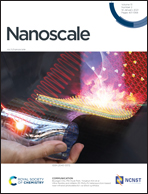Copper decorated with nanoporous gold by galvanic displacement acts as an efficient electrocatalyst for the electrochemical reduction of CO2†
Abstract
The reduction of carbon dioxide (CO2) is recognized as a key component in the synthesis of renewable carbon-containing fuels. Herein, we report on nanoporous gold (NPAu) decorated with copper atoms for the efficient electrochemical reduction of CO2. A facile and green galvanic displacement technique was developed to incorporate Cu onto the surface of the nanoporous gold-zinc (NPAuZn) electrode. The effect of zinc on the morphology and electrochemical performance of the formed NPAuCu electrodes for CO2 reduction was systematically investigated. The NPAuCu electrode exhibited 16.9 and 2.86 times higher current density than those of polycrystalline gold and NPAuZn at −0.60 V (vs. RHE) in a 0.1 M CO2-saturated NaHCO3 solution, respectively. A far higher faradaic efficiency was achieved at the NPAuCu electrode for the electrochemical reduction of CO2 to CO, CH4 and HCOOH. The facile synthesis of the NPAuCu electrode demonstrated in the present study can be employed as a promising strategy in the development of high-performance electrocatalysts for energy and environmental applications.



 Please wait while we load your content...
Please wait while we load your content...